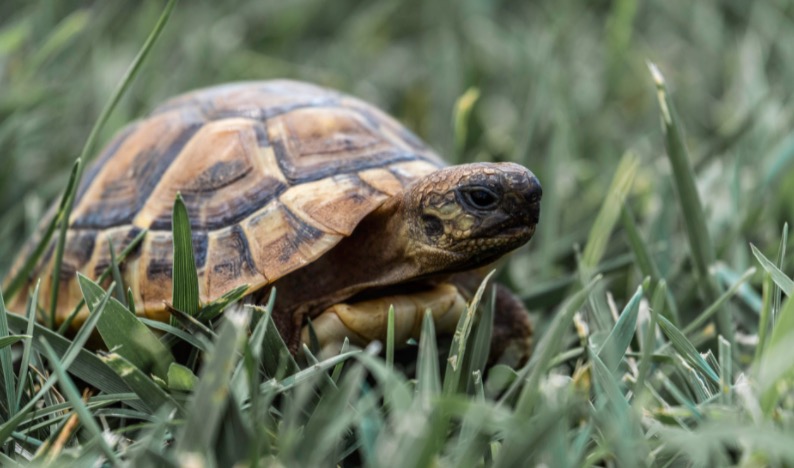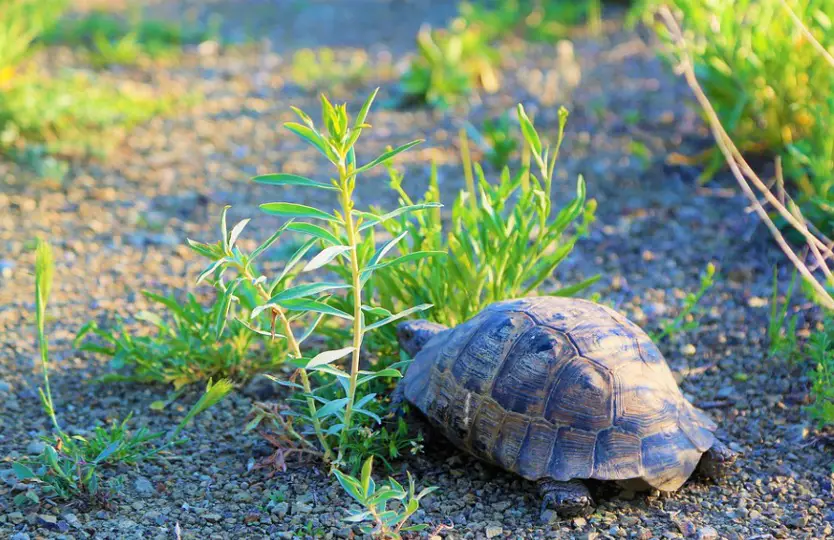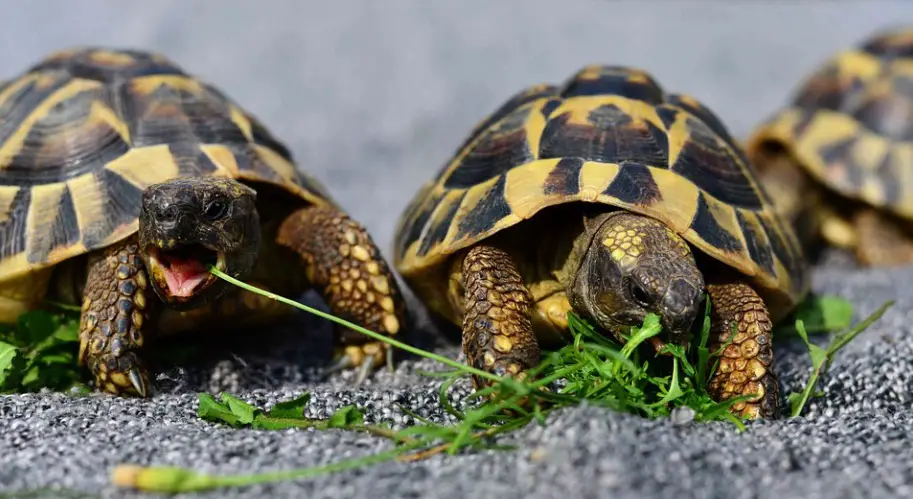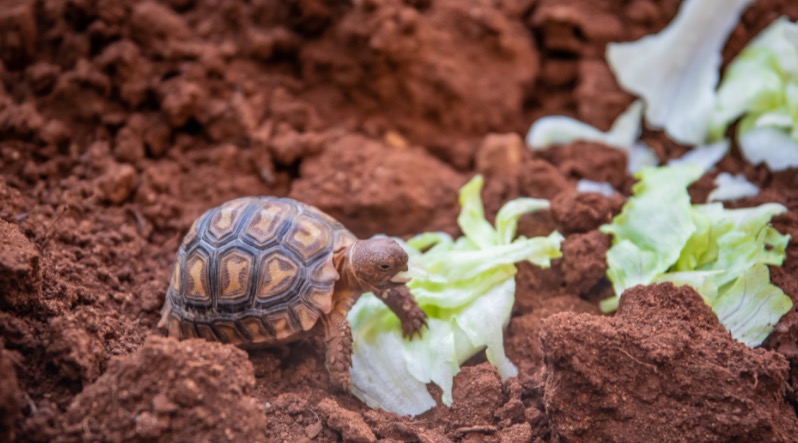Table of Contents
Russian Tortoise: All You Need To Know
A Russian tortoise is a roaming desert herbivore which belongs to the kingdom of Animalia, phylum Chordata, and class Reptilia. Its genus is Agrionemys and its species is Agrionemys horsfieldii. Its length is about 13 to 25 cm and it weighs about less than 2.2 kg. It lives in the arid regions of Russia and Central Asia, with a lifespan of up to 100 years.

Russian Tortoise Description
The Russian tortoise is a species of tortoise that is endemic to Russia and Central Asia. This tortoise, also known as the Afghan tortoise, Horsfield’s tortoise, or the “four-clawed” tortoise, is well-adapted to dry desert settings and has a unique shell colouring. The tortoise is often pale yellow in colour with prominent black spots on the shell’s scutes. While the Russian tortoise is a popular pet, it is a vulnerable species in the wild.

The Russian tortoise is one of the world’s longest-living animals, with a lifetime of up to 100 years — a group known as “supercentenarians.” In areas where it becomes cold for lengthy periods of time, the Russian tortoise may hibernate for up to 9 months out of the year. In late spring, tortoises emerge from hibernation, feed and breed in the summer, and then return to sleep for the rest of the year.
Hibernation can be much shorter in captivity, but it is still necessary for the health of many reptile species and should not be missed altogether.
Russian tortoises, for example, have a rather complicated mating ritual. In order to get a female to mate, males will bob their heads, circle, and bite her forelegs. If she agrees, she will give up her attempts to flee the male and allow him to mount her.
Males may make amusing squeaking noises during mating, and females may dig a nest to deposit eggs in shortly after. Before baby tortoises emerge, eggs must grow for 8-10 weeks. For a few weeks, baby Russian tortoises keep their yolk sacs to help them establish themselves before they must begin feeding regularly.

Fun Facts About Russian Tortoise!
Russian tortoises are widely maintained as pets, although few owners are aware of their animals’ true potential. Russian tortoises, in fact, are wonderful illustrations of numerous key biological ideas.

Russian Tortoise: Supercentenarian Lifespan
Only a few creatures on the globe can live for more than 100 years. These creatures, known as supercentenarians, may be found in a variety of animal groups. While large creatures like whales and sharks have been known to survive far over a century, it is less typical in smaller species (though many tiny organisms are theoretically eternal).
The Russian tortoise, on the other hand, isn’t the only tiny mammal that may survive for almost a century. The tuatara, bigmouth buffalo fish, lobsters, and a variety of molluscs and worms are among the other tiny supercentenarians. Though much more study is needed to understand how these animals can survive for so long, one popular idea revolves around chromosomal telomeres.
Telomeres are DNA repeats that can be found on both ends of a chromosome. Telomeres are considered to break down over time, resulting in non-functional DNA when the telomere wears off completely. Extending telomeres are now being studied to determine if they may add years to the lives of species that do not typically have lengthy lives.
Desert Adaptations
Because they live in an environment lacking life’s most important substance: water, desert animals have some of the most remarkable adaptations. Russian tortoises, like many desert creatures, must obtain the majority of their water from their diet. By consuming things like lettuce, fruits, and vegetables, these tortoises are able to acquire adequate water without ever needing to drink water.
These tortoises have a variety of characteristics that allow them to do so. First, compared to animals that dwell in more humid, rainy environments, their digestive tract is better at absorbing water. Furthermore, these turtles’ kidneys are believed to have evolved to utilise less water to eliminate waste materials from the circulation.
A huge, domed shell and fat reserves that can retain water for a long period are two more adaptations. In fact, because these tortoises may hibernate for up to 9 months, their bodies must be able to retain enough water to last that long. It is not essential to deprive Russian tortoises of water in captivity.
On occasion, they love being bathed in shallow, warm water. In addition, if your tortoise’s food does not contain enough water on its own, this will help them keep hydrated.
Temperature-dependent Sex Determination
The chromosomes acquired from its parents do not determine the sex of a young Russian tortoise, unlike many other reptiles. Males are created when the temperature in the incubator is lower, whereas females are formed when the temperature is greater.
Nests in the wild are flawed, with regions of high and low temperatures, resulting in the birth of both males and females from the same nest. Eggs are incubated at particular temperatures in captivity, allowing breeders to choose whether males or females are born.
While this is a fantastic trait for reptile breeders attempting to create particular sex, animals with temperature-dependent sex determination may face difficulties when the global climate changes and some parts of the world heat up.
If global warming continues, Russian tortoises will be able to spawn only females, and the species would go extinct. Crocodiles, turtles, and numerous lizard species are among the animals that determine sex by the temperature at which eggs are incubated.
Russian Tortoise Citations
- Russian tortoises (Agrionemys horsfieldi) as a potential reservoir for Salmonella spp. Res Vet Sci . 2012 Apr;92(2):187-90.
- Reptiles in Space Missions: Results and Perspectives. Int J Mol Sci . 2019 Jun 20;20(12):3019.
- Cryptosporidiosis caused by two distinct species in Russian tortoises and a pancake tortoise. Vet Parasitol . 2010 May 28;170(1-2):14-9.







